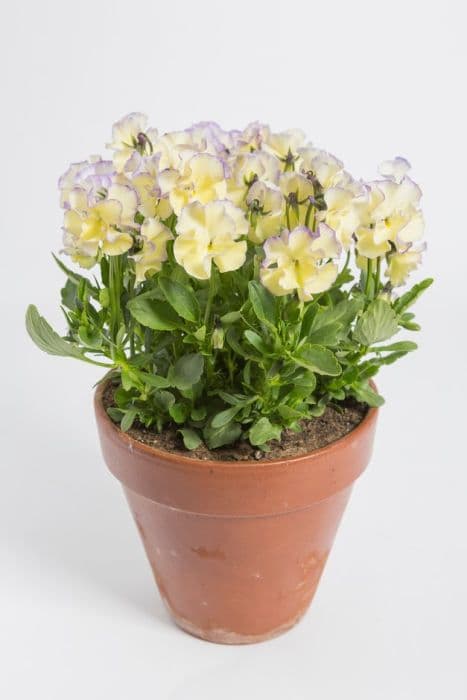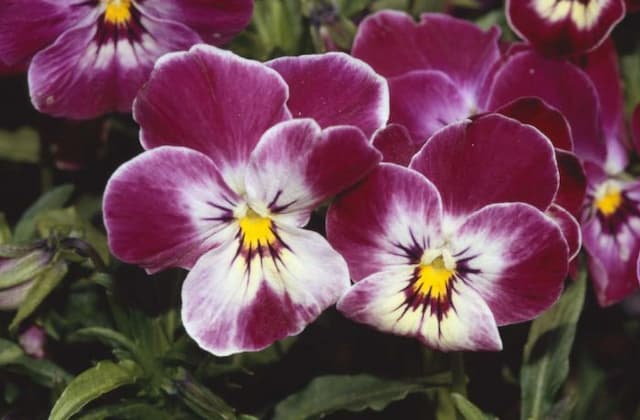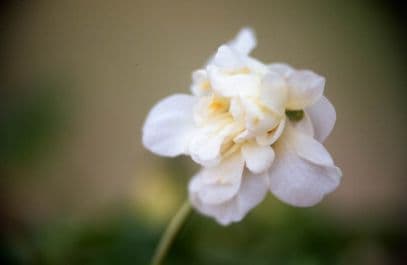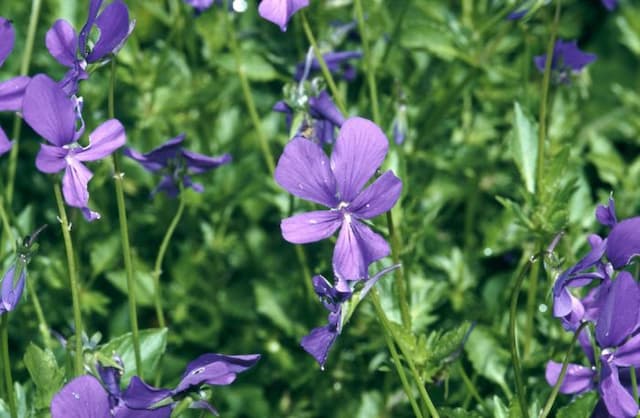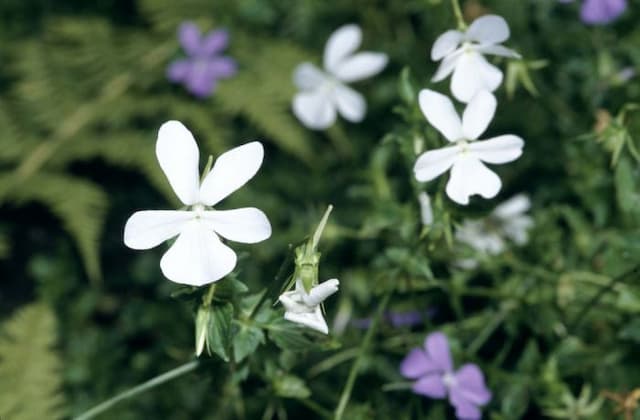Pansy Viola 'Huntercombe Purple' (Va)

ABOUT
Viola 'Huntercombe Purple' is a cultivar known for its distinctive and charming appearance. This plant is recognized for its vibrant purple flowers, which exhibit a delicate yet striking hue, capable of catching the eye of any passerby. The blooms typically present a classic viola shape, with five rounded petals that often have a velvety texture. The central petal usually has markings or veins, which may be a slightly different shade and add depth to the overall floral display. The foliage of 'Huntercombe Purple' consists of small, green leaves that form a lush backdrop to the vivid flowers. The leaves are often heart-shaped with a slight point at the tip, providing a soft, textured greenery that complements the flowers perfectly. As with many other viola varieties, the leaves may also have a slightly serrated edge, giving them a subtle, ruffled appearance. Together, the flowers and foliage of Viola 'Huntercombe Purple' create a picturesque palette of purples and greens, making this plant a lovely addition to any garden setting where it can create a tapestry of cool-toned colors. It is notable for its long blooming period, which allows one to enjoy its beauty across multiple seasons, weather permitting. Overall, the appearance of this plant exudes a serene elegance, perfect for adding a splash of color to garden beds, borders, or containers.
About this plant
 Names
NamesFamily
Violaceae
Synonyms
Huntercombe Purple Viola, Purple Garden Pansy, Huntercombe Purple Pansy
Common names
Viola 'Huntercombe Purple'.
 Toxicity
ToxicityTo humans
The common name for Viola 'Huntercombe Purple' is pansy. Pansies are not considered toxic to humans. In fact, pansy flowers are edible and are sometimes used as a garnish or decoration in culinary applications. They do not typically cause symptoms of poisoning if ingested.
To pets
The common name for Viola 'Huntercombe Purple' is pansy. Pansies are generally regarded as safe for pets, including dogs and cats, and are not known to be toxic. Ingesting pansies should not lead to symptoms of poisoning in pets. However, it is always possible for an individual animal to have a sensitive reaction to a new food or plant material. If there are signs of distress after ingestion, such as vomiting or diarrhea, it is recommended to consult a veterinarian.
 Characteristics
CharacteristicsLife cycle
Perennials
Foliage type
Evergreen
Color of leaves
Green
Flower color
Purple
Height
6 inches (15 cm)
Spread
6 inches (15 cm)
Plant type
Herb
Hardiness zones
5
Native area
Europe
Benefits
 General Benefits
General Benefits- Attracts Pollinators - The Viola 'Huntercombe Purple' or Pansy attracts bees, butterflies, and other beneficial insects, which help pollinate surrounding plants.
- Aesthetic Appeal - With its vibrant purple flowers, this pansy adds color to gardens, borders, and containers.
- Extended Blooming Season - Pansies generally have a long flowering period, providing color and interest throughout multiple seasons.
- Low Maintenance - This variety of viola is known for being hardy and relatively easy to care for, requiring minimal maintenance.
- Versatility - Pansies can be used in a variety of garden settings, including rock gardens, window boxes, and hanging baskets.
- Drought Tolerance - Once established, these plants can tolerate periods of drought, making them suitable for a range of climatic conditions.
 Medical Properties
Medical PropertiesThis plant is not used for medical purposes.
 Air-purifying Qualities
Air-purifying QualitiesThis plant is not specifically known for air purifying qualities.
 Other Uses
Other Uses- Edible decorations: The flowers of the pansy can be used to garnish salads, desserts, and drinks, adding a splash of color and a subtle floral flavor.
- Natural dye: Pansies can be used to make a natural dye for fabrics or Easter eggs, producing beautiful shades of blue and purple.
- Vegetable confetti: Dried pansy petals can be sprinkled over vegetable dishes as a decorative and edible confetti.
- Ice cube enhancers: Pansy flowers can be frozen in ice cubes to create an elegant touch to beverages during a special event.
- Botanical art: Pressed pansy flowers can be used in creating botanical art, such as bookmarks, greeting cards, and framed artwork.
- Flower crafts: The colorful pansy petals can be utilized in DIY crafts, like making homemade soaps, candles, or potpourri.
- Garden companion planting: Pansies can be used as companion plants in the garden to provide ground cover and deter certain pests.
- Visual learning tools: Due to their distinct face-like markings, pansies can be used in educational settings to help teach children about the parts of a flower.
- Photography subject: Their vibrant colors and patterns make pansies a favorite subject for photographers and nature enthusiasts.
- Floral arrangements: Although not long-lasting as cut flowers, pansies can be floated in water to create temporary, but stunning, aquatic floral arrangements.
Interesting Facts
 Feng Shui
Feng ShuiThe Viola is not used in Feng Shui practice.
 Zodiac Sign Compitability
Zodiac Sign CompitabilityThe Viola is not used in astrology practice.
 Plant Symbolism
Plant Symbolism- Modesty: The humble appearance of the common violet can signify modesty or humility.
- Faithfulness: Violets are often associated with steadfastness and loyalty in relationships.
- Spiritual Wisdom: The violet, particularly in its deep purple hue typical of 'Huntercombe Purple,' can symbolize a deep spiritual insight or wisdom.
- Innocence: Commonly, violets represent innocence, suggesting a pure and untouched aspect of nature.
 Water
WaterPansies like the Viola 'Huntercombe Purple' should be watered deeply and thoroughly whenever the top inch of soil has dried out. During hot summer months, this may mean watering every day, especially if the pansies are in containers. In cooler temperatures or during rainfall, reduce the frequency, possibly to once a week. Each watering session should aim to provide enough water to moisten the soil to a depth of about 6 inches. As a rule of thumb, this often means providing about 1 gallon of water per square yard of soil every week during the active growing season.
 Light
LightPansies, such as the Viola 'Huntercombe Purple,' thrive best in full to partial sunlight. The ideal spot for these flowers would be in an area where they can receive at least 6 hours of direct sunlight each day while being protected from the harsh afternoon sun, which could be too intense and cause the blooms to fade. They can tolerate some shade, particularly in hotter regions, which helps protect their vibrant colors.
 Temperature
TemperaturePansies like the Viola 'Huntercombe Purple' fare well in cooler temperatures and can survive light frosts. They prefer temperatures ranging from 40°F to 60°F and can withstand minimum temperatures as low as 20°F for short periods. Ideal growth is seen in fall and spring, with pansies often struggling in hot summer conditions above 80°F.
 Pruning
PruningPansies like the Viola 'Huntercombe Purple' benefit from deadheading, which is the process of removing spent flowers. This practice encourages more blooms and prevents the plants from putting energy into seed production. Prune pansies regularly, ideally every week during the blooming season, to keep them looking their best. The best time for pruning is when the flowers start to fade and before they set seed.
 Cleaning
CleaningAs needed
 Soil
SoilPansies like Viola 'Huntercombe Purple' prefer well-draining, fertile soil with a pH range of 6.0 to 6.5. A mixture of loamy soil, peat moss, and perlite or sand is ideal to provide the necessary drainage and nutrient content.
 Repotting
RepottingPansies like Viola 'Huntercombe Purple' should be repotted annually to refresh the soil and provide room for growth, preferably in the spring before the growing season.
 Humidity & Misting
Humidity & MistingViola 'Huntercombe Purple', like other pansies, prefers moderate humidity and will thrive in typical outdoor humidity levels, without requiring special humidity adjustments.
 Suitable locations
Suitable locationsIndoor
Place in bright indirect light, ensure good airflow.
Outdoor
Plant in partial shade, protect from extreme heat.
Hardiness zone
6-9 USDA
 Life cycle
Life cycleViola 'Huntercombe Purple', commonly known as a variety of pansy, begins its life cycle as a seed which, when sown, will germinate in cool, moist conditions. Upon sprouting, the seedling goes through a phase of vegetative growth, developing a rosette of leaves and a strong root system. As it matures, the pansy enters the flowering stage, producing distinctive purple flowers that can bloom in cooler weather, typically in spring and fall. After pollination, which may be aided by insects, the plant will produce seeds, completing the reproductive cycle. In areas with mild winters, pansies can be biennial, surviving the off-season to bloom again, but in harsher climates, they are treated as annuals. With the setting of the seeds or the death of the plant due to environmental stresses, the life cycle reaches its conclusion, though seeds may lay dormant until conditions are favorable for a new generation to begin.
 Propogation
PropogationPropogation time
Spring to Summer
Propogation: The most popular method of propagation for the Viola 'Huntercombe Purple', commonly known as the violet, is through seed sowing. To propagate violets from seeds, begin by sowing the seeds indoors during late winter to early spring. Fill a tray with a well-draining seed starting mix and lightly press the seeds into the soil, ensuring they are not buried too deeply as they require light for germination. Keep the soil consistently moist but not waterlogged, and maintain a temperature range between 65-75 degrees Fahrenheit (18-24 degrees Celsius). Germination can take anywhere from 14 to 30 days. Once seedlings have developed a couple of true leaves and are large enough to handle, they can be transplanted into individual pots or direct sow outdoors once the danger of frost has passed.
